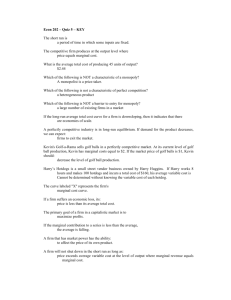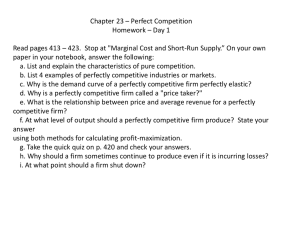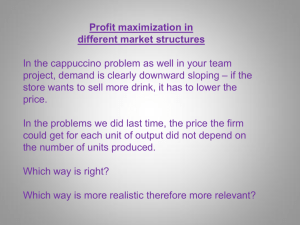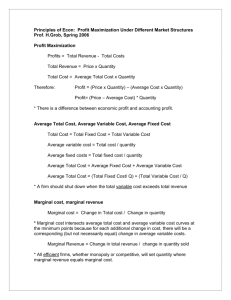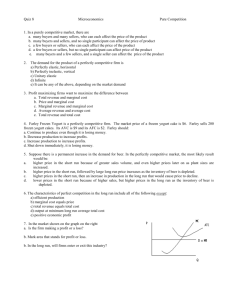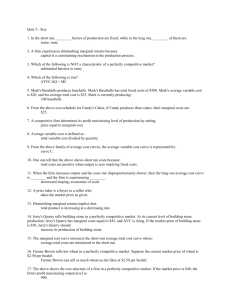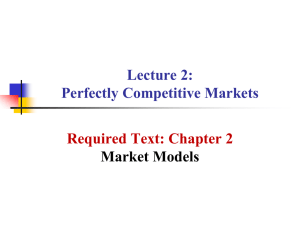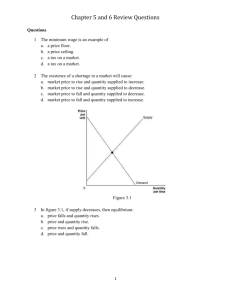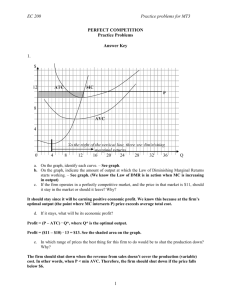Unit_III_Review_Multiple_Choice_Questions
advertisement
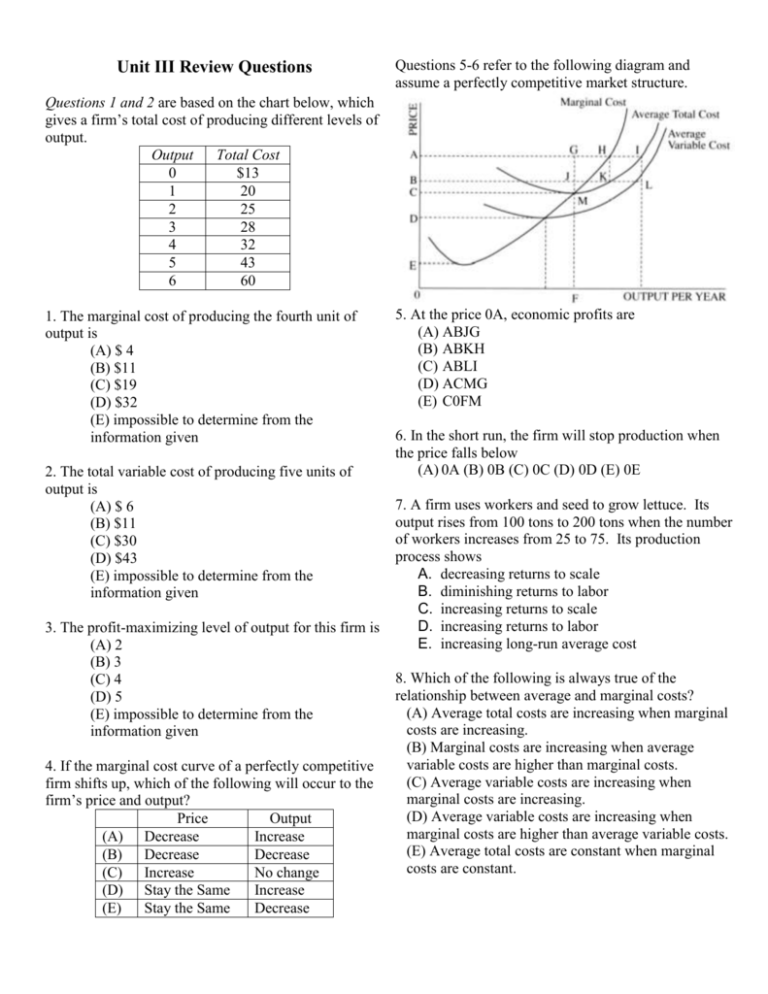
Unit III Review Questions Questions 5-6 refer to the following diagram and assume a perfectly competitive market structure. Questions 1 and 2 are based on the chart below, which gives a firm’s total cost of producing different levels of output. Output Total Cost 0 $13 1 20 2 25 3 28 4 32 5 43 6 60 1. The marginal cost of producing the fourth unit of output is (A) $ 4 (B) $11 (C) $19 (D) $32 (E) impossible to determine from the information given 2. The total variable cost of producing five units of output is (A) $ 6 (B) $11 (C) $30 (D) $43 (E) impossible to determine from the information given 3. The profit-maximizing level of output for this firm is (A) 2 (B) 3 (C) 4 (D) 5 (E) impossible to determine from the information given 4. If the marginal cost curve of a perfectly competitive firm shifts up, which of the following will occur to the firm’s price and output? Price Output (A) Decrease Increase (B) Decrease Decrease (C) Increase No change (D) Stay the Same Increase (E) Stay the Same Decrease 5. At the price 0A, economic profits are (A) ABJG (B) ABKH (C) ABLI (D) ACMG (E) C0FM 6. In the short run, the firm will stop production when the price falls below (A) 0A (B) 0B (C) 0C (D) 0D (E) 0E 7. A firm uses workers and seed to grow lettuce. Its output rises from 100 tons to 200 tons when the number of workers increases from 25 to 75. Its production process shows A. decreasing returns to scale B. diminishing returns to labor C. increasing returns to scale D. increasing returns to labor E. increasing long-run average cost 8. Which of the following is always true of the relationship between average and marginal costs? (A) Average total costs are increasing when marginal costs are increasing. (B) Marginal costs are increasing when average variable costs are higher than marginal costs. (C) Average variable costs are increasing when marginal costs are increasing. (D) Average variable costs are increasing when marginal costs are higher than average variable costs. (E) Average total costs are constant when marginal costs are constant. 9. If a perfectly competitive industry is in long-run 12. Refer to Figure 14. If the product’s price is equilibrium, which of the following is most likely to be constant at $47.00, to maximize profits this firm will true? produce: (A) Some firms can be expected to leave the industry. A. zero, the firm will lose money by producing (B) Individual firms are not operating at the minimum any level of output points on their average total cost curves. B. zero in the short run, but 6 in the long run (C) Firms are earning a return on investment that is C. zero in the long run, but 6 in the short run equal to their opportunity costs. D. 1 in the short run, but 7 in the long run (D) Some factors are not receiving a return equal to E. 7 in the long run, but 2 in the short run their opportunity costs. (E) Consumers can anticipate price increases. Figure 1 10. If the current price for the perfectly competitive firm represented in Figure 1 is $10.00, what would be the result of an increase in fixed cost on the firm’s profit maximizing price and quantity? A. Price increase and Quantity increase B. Price increase and Quantity decrease C. Price constant and Quantity constant D. Price decrease and Quantity decrease E. Price decrease and Quantity increase Figure 14 Quantity of Output 0 1 2 3 4 5 6 7 8 Average Variable Cost 50 45 41.7 40 40 40.8 42.1 44.3 Average Marginal Total Cost Cost 250 50 145 40 108.4 35 90 35 80 40 74.1 45 70.7 50 69.3 60 11. Refer to Figure 14. The average fixed cost of producing 4 units of output is: A. 35 B. 40 C.50 D. 90 E. 200 Figure 5 13. The profit-maximizing price for a perfectly competitive firm like the one shown in Figure 5 in the long run would be; A. A B. B C. C D. D E. E 14. In Figure 5 at a market price of A, the profitmaximizing output for a perfectly competitive firm is A. 0 B. 1 C. 2 D. 3 E. 4 - 15. If one firm in a perfectly competitive industry experiences a technological breakthrough that lowers only that firm’s cost of production, which of the following correctly describes the effect on this firm’s price, quantity, and profit? Price Quantity Profit A. decrease decrease decrease B. decrease increase increase C no change decrease increase D no change increase increase E increase increase increase Unit 3 Review Quiz Answers 1.A 2.C 3.E 4.E 5.B 6.D 7.B 8.D 9.C 10.C 11.C 12.C (Good question. 0 – LR, 6 – SR) 13.D 14.A 15.D

